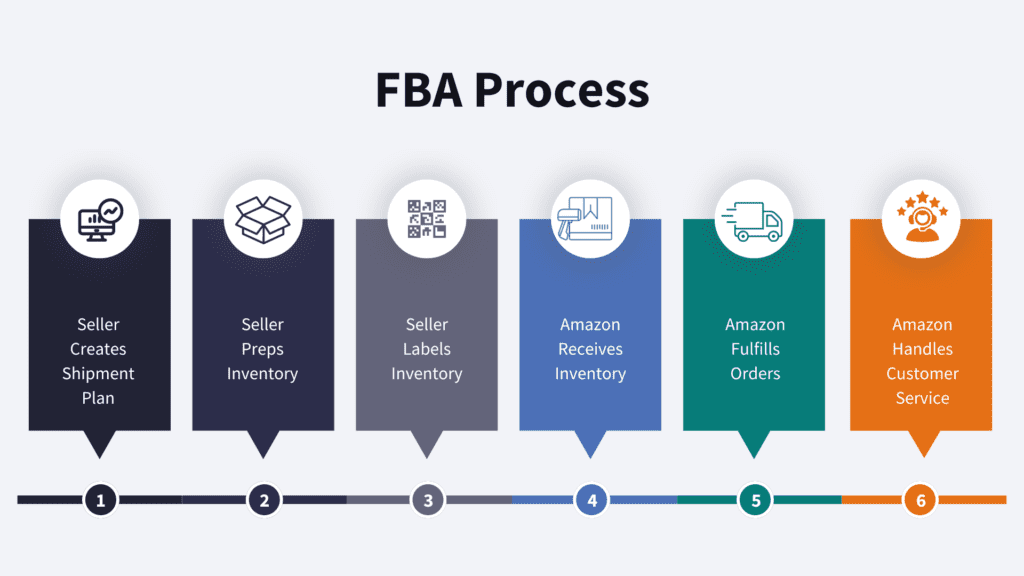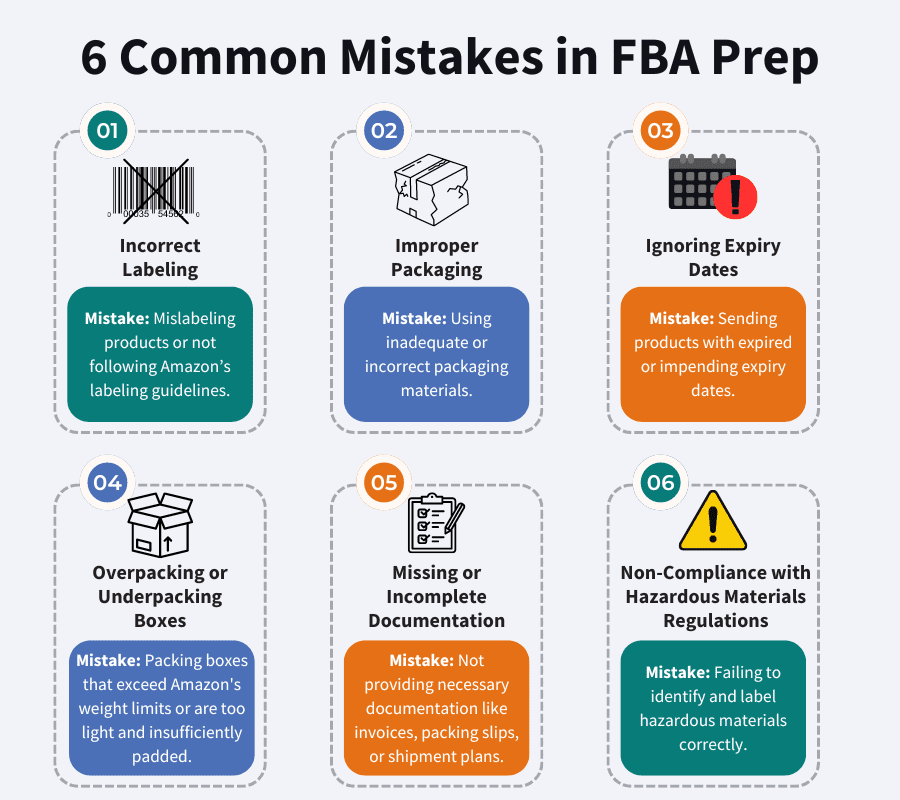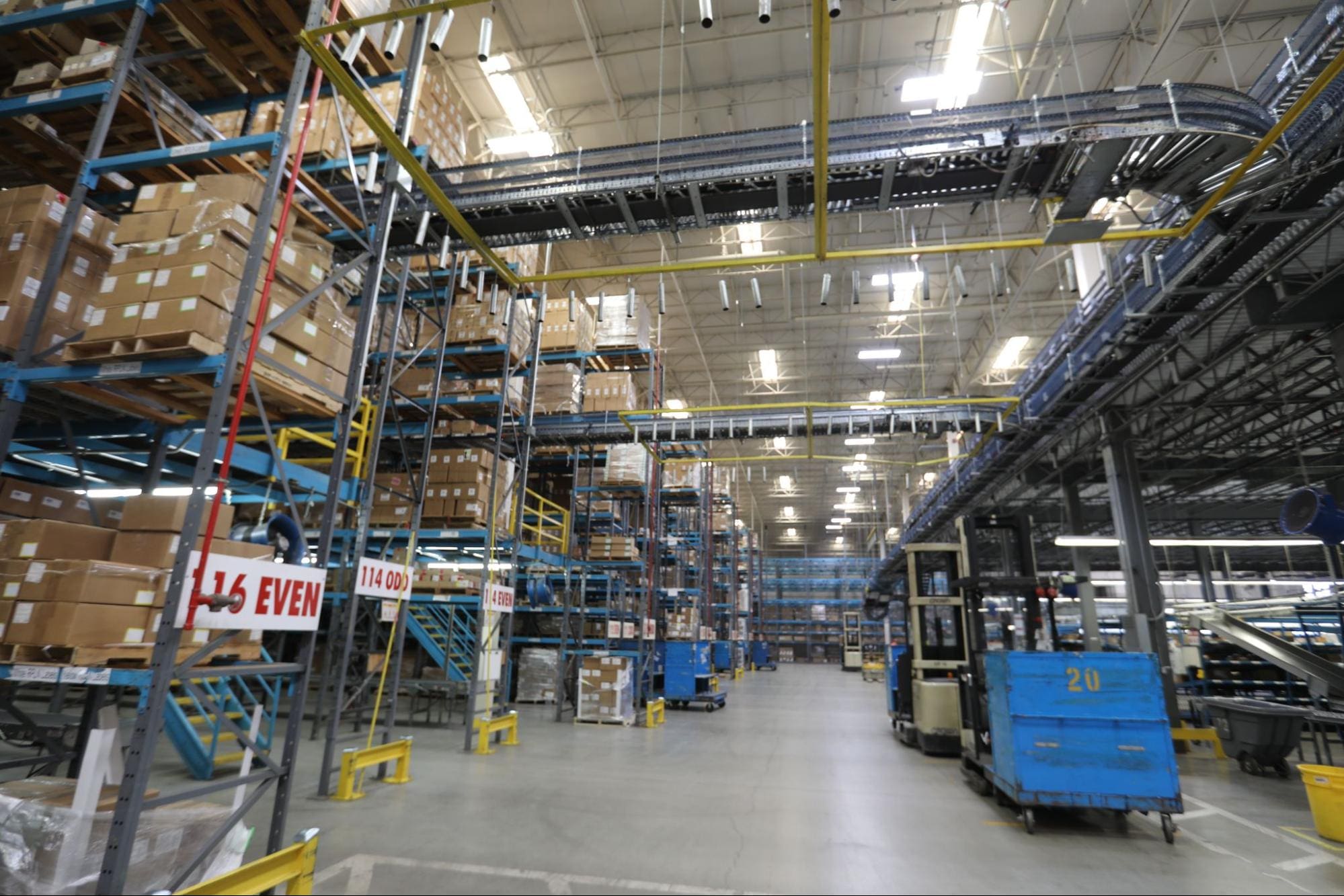FBA prep is critical for Amazon sellers leveraging FBA for Amazon fulfillment. Sending products to Amazon’s fulfillment centers requires more than just boxing and shipping. Improperly prepared items lead to costly fees, inventory delays, and account suspensions. Investing in product sourcing only to have items sit in limbo due to Amazon’s requirements impacts your bottom line.

But here’s the good news: Mastering FBA prep doesn’t have to be a headache. With the right knowledge and approach, you can streamline your prep process, avoid common pitfalls, and set your Amazon business up for success.
This guide covers FBA prep essentials from the basics to advanced strategies.
What Is FBA?
FBA (Fulfillment by Amazon) is Amazon’s warehouse and logistics solution for Amazon sellers of all sizes. Through FBA, Amazon sellers can send their inventory to Amazon fulfillment centers nationwide, allowing them to meet customer’s expectations of shipping within 1 to 2 days while getting the coveted “Prime” badge on their listings.
FBA simplifies order fulfillment strategies by handling warehousing and logistics end-to-end. Amazon will pick, pack, and ship your products to customers who order from you on the platform.
To use FBA, you must prepare your orders according to Amazon’s strict guidelines, which include proper product labeling, secure packaging, and adherence to weight and size limits. These guidelines exist to provide an efficient FBA program.
We advise sellers to follow the guidelines carefully to maintain good seller account health, avoid additional fees, and ensure their products are ready for quick and efficient fulfillment.
How Does FBA Work?
FBA is a fairly straightforward process.

1. Create a Shipment Plan
You create a shipment plan in Amazon Seller Central by telling Amazon how much inventory you’ll send in based on your seller account’s storage limits and select a shipping carrier. Depending on where your warehouse is based, you may be eligible for discounted shipping rates thanks to the Amazon Partnered Carrier program.
2. Prep Inventory
Your warehouse, manufacturer, or supplier preps the inventory to send to FBA based on their FBA Prep Guidelines (more on this later).
3. Label Inventory
Your warehouse, manufacturer, or supplier then labels the inventory with the labels provided by Amazon Seller Central’s shipment plan and ships it to Amazon warehouses around the country. Amazon will predict where the demand is and inform you which fulfillment centers to ship to.
4. Amazon Receives Inventory
As Amazon receives your shipments, they’ll begin scanning them and making them available for sale on Amazon.
5. Amazon Fulfills Orders
From there, when a customer orders, Amazon will ship the order from the closest fulfillment center.
6. Customer Service
If a customer has a question or wishes to return an order, Amazon’s customer service will handle this, not you.
How Amazon Measures FBA Business Success
Amazon measures an efficient and successful FBA business through its Inventory Performance Index (IPI). Your IPI impacts how much space you’re allotted in Amazon fulfillment centers. IPI is represented in a number from 0–1,000. The higher the number, the better.
Scores of 400 or higher lead to benefits for seller access to unlimited space in FBA.
Your IPI consists of the following metrics:
- Excess Inventory Percentage – Excess inventory is inventory that has more than 90 days of supply based on the forecasted demand and is carried over every time you’re charged for storage.
- Sell-Through – This represents the units sold compared to the initial inventory. This metric is calculated by counting the total items and units shipped in the last 90 days and dividing it by the average number of items in stock at FBA during that same period.
- Stranded Inventory Percentage – This is the percentage of unsellable inventory at Amazon fulfillment centers.
- In-Stock Rate – This indicates how well you keep your popular inventory in stock and shows how much inventory you have of a current listing. In-stock rate percentage is the percentage of the time during the previous 30 days your replenishable Amazon Standard Identification Numbers (FBA ASINs) have been in stock and weighted by the total number of units sold for the last 60 days.
In short, Amazon wants you to send in only enough inventory to sell out in 14 days.
The Pros and Cons of FBA
It’s important to consider the pros and cons of FBA before deciding to move forward with it for your business.
Pros
FBA offers numerous benefits that can boost your business growth and customer satisfaction.
Prime Eligibility and Increased Visibility
Prime sellers offer fast delivery courtesy of FBA, so Amazon shoppers can click more on their profiles and buy more from them. This leads to increased visibility and sales.
Efficient Logistics and Shipping
Signing up for FBA grants you access to Amazon’s upscale logistics system that guarantees fast and seamless delivery, often with the added benefit of Prime eligibility for your products.
This enhances your order fulfillment, improving customer satisfaction and repeat purchases.
Storage and Inventory Management
FBA allows your goods to go directly from the manufacturer or supplier to an Amazon fulfillment center, which provides secure storage, real-time inventory tracking, and automated restocking alerts.
Customer Service and Returns Handling
As an FBA user, if a customer has concerns or questions about your product or wishes to make a return, Amazon’s expert customer service team handles all inquiries and returns.
With a proven track record of improving customer experience, this team will help boost your seller’s reputation.
Cons
While FBA has its advantages, sellers should be aware of potential drawbacks affecting operations and profitability.
Cost
Besides the base-line FBA cost calculated using product tiers, Amazon charges additional fees for services like long-term storage, returns processing, inventory removal, etc.
When your FBA cost becomes too high, you risk significantly eroding profit margins.
Lack of Branding Control
Amazon has strict FBA Prep rules you have to stick to avoid penalties, back-shipping, and suspensions.
These strict FBA Prep rules prevent you from customizing your packaging, reducing brand differentiation and potentially impacting customer experience since products are shipped in standard Amazon packaging.
Inventory Management Challenges
Amazon’s FBA system predicts inventory levels based on your seller data.
However, if you understock or overstock based on these predictions, Amazon doesn’t compensate for missed orders, and you’ll need to pay for long-sitting inventory.
Competition with Amazon
Amazon also sells similar products to other sellers and delivers them through FBA.
This competition often forces sellers to reduce their chances of getting orders, negatively impacting sales and profit.
Lenient Return Policy
FBA accepts returns for nearly any reason and items in nearly any condition. The policy allows little protection against inventory loss and return fraud.
Common Mistakes in FBA Prep and How to Avoid Them
Amazon sellers often make the following mistakes while preparing their goods for FBA.

Incorrect Labeling
Proper product labels for FBA require three essential components:
- A FNSKU (Fulfillment Network Stock Keeping Unit)
- The product’s name (e.g., CeraVe Acne Foaming Facial Cleanser 150g)
- The product’s condition (e.g., new)
You’re labeling incorrectly if you omit any of these components or provide incorrect information — such as the wrong FNSKU, name, or condition. Mislabeling products or failing to adhere to Amazon’s labeling guidelines could also lead to additional fees, removal, and return or refusal of items.
Improper Packaging
If you use inadequate or incorrect packaging materials, it can damage products and cause negative customer reviews. Amazon’s FBA guidelines specify how to package each product category and the proper use of each packaging material.
Ensure proper packaging materials that meet Amazon’s requirements for your product type. Choose boxes that fit snugly with minimal cushioning and fill empty spaces to prevent shifting. For fragile items, use individual protective wrapping, and always seal boxes securely.
Missing or Incomplete Documentation
Inadequate documentation (invoices, packing slips, shipment plans) can disrupt FBA processing, causing rejections or delays. Create a checklist of required documents for your products and shipment methods.
Before shipping, carefully review this list, ensuring all documents are present and accurate, especially product details and tracking numbers.
Overpacking or Underpacking Boxes
Overpacking happens in two ways: when boxes exceed Amazon’s 50-lb. (22.68-kg) weight limit or when excessive materials or oversized boxes are used. Underpacking occurs when boxes lack sufficient padding or are too large for their contents, risking transit damage.
Follow Amazon’s weight and dimension guidelines and use adequate padding materials to avoid these issues.
Ignoring Expiry Dates
Each product sent to FBA must have an expiration date labeled MM-DD-YYYY or MM-YYYY for products other than medical devices with YYYY-MM-DD format.
Avoid shipping products with expired or impending expiry dates. Amazon requires that expiration-dated products have a minimum remaining shelf life upon receipt at their fulfillment centers for the product to be consumed within an additional 90 days.
Use fulfillment software with advanced expiry date tracking that can automate tracking expiry dates and send alerts when products are nearing their expiration, allowing you to take proactive steps.
Non-Compliance with Hazardous Materials Regulations
Regulations for hazardous materials (products that contain dangerous chemicals, flammable substances, or toxic materials) exist to protect you, your shipment, and supply chain workers. Failing to comply with hazardous materials regulations poses significant safety risks, legal issues, and account suspensions.
Properly identify hazardous materials and follow Amazon’s handling guidelines to ensure safety and compliance.
Is FBA Worth It?
If this sounds like your business, yes! FBA is worth it.
- You can send in small amounts of inventory and sell through them frequently.
- Amazon is not in the warehousing business; they don’t want to keep your inventory.
- You want the coveted “Prime” badge to let customers know they can get your product in two days if they’re a Prime customer.
- This will boost click-through rates and conversion rates (unit session percentage).
- Your products aren’t better suited for Seller Fulfilled Prime (SFP).
That said, you still need to prep the products before you send them to Amazon.
So, how do you handle FBA prep?
How to Prep Items for FBA
Amazon Sellers are required to prepare their inventory before sending it to FBA.

If your product doesn’t have a Unit Session Percentage (UPC) printed on it, Amazon can print and sticker it with the FNSKU (the ASIN) for a fee of $0.55, but you still have to prepare the products in advance.
Each product category has different FBA prep requirements. For a complete list of categories and precise FBA prep requirements, read Amazon’s prep guidelines.
With that in mind, here are the general guidelines you should follow for FBA prep.
- Boxes must not exceed the standard weight limit of 50 lbs. unless they contain one oversized item that exceeds 50 lbs.
- For a single oversized item that exceeds 50 lbs., attach a label that indicates “Team Lift” on the top and sides of the box.
- For a single oversized item that exceeds 100 lbs., attach a label that clearly shows “Mechanical Lift” on the top and sides of the box.
- If shipping pallets, boxes must not overhang by greater than 1 inch.
- Pallets should be shrink-wrapped.
- Make sure pallets don’t exceed 72″ in height or 1,500 lbs. in weight.
- Remove all other shipping markings and stickers to avoid conflicts with Amazon scanners.
- Expiration dates must be visible on the packaging.
- Avoid using packaging peanuts, crinkle paper, or shredded paper.
FBA FAQs
Here are some common questions about FBA and their answers.
Do I Get Unlimited Space Using FBA?
No, the space you’re allotted in Amazon fulfillment centers is based on your Inventory Performance Index score.
How Are Returns Handled for FBA?
When customers request a return, Amazon instantly accepts the return and takes the money from your upcoming disbursement, then provides the customer with a return shipping label to return the item to the closest warehouse.
Amazon uses the honor system with customers to return the product within 45 days.
After Amazon receives the return, the warehouse will inspect the item and the customer’s return reason, then make a decision on whether the item is still sellable or not.
How Much Does FBA Cost?
Amazon charges fulfillment fees based on product size tiers. These consist of product category types, shipping weights, and shipping dimensions.
The size tiers (for items excluding apparel) are:
- Small standard size – $3.06–$3.63
- Large standard size – $3.68–$6.92 + $0.08 per 4 oz. interval above the first 3 lbs.
- Large bulky – $10.33 + $0.38 per lb. interval above the first lb.
- Extra-large 0 to 50 lbs. – $28.44 + $0.38 per lb. interval above the first lb.
- Extra-large 50+ to 70 lbs. – $43.33 + $0.75 per lb. interval above 51 lbs.
- Extra-large 70+ to 150 lbs. – $61.94 + $0.75 per lb. interval above 71 lbs.
- Extra-large 150+ lbs. – $219.53 + $0.19 per lb. interval above 151 lbs.
Click here for a full list of FBA fees.
While, at first glance, FBA may seem like an economical fulfillment option, beware of hidden fees like inbound placement fees and low inventory level fees. In the video below, long-time Amazon seller Suman Singh explains how FBA’s hidden fees can add up and limit your growth on Amazon.
Mastering FBA Prep with Ware2Go: Boost Your Amazon Selling Success
FBA Prep might be complicated, but you need to get it right to avoid extra fees and account suspensions. Proper product preparation ensures your products meet Amazon’s requirements, optimizing your fulfillment strategy and enhancing customer satisfaction. Therefore, understanding the FBA Prep process is essential for long-term success, whether handling prep in-house or using a service.
For sellers aiming to simplify operations to focus on scaling, partnering with an experienced fulfillment provider like Ware2Go can be a game-changer. Our solutions, including expert FBA prep services, help you effortlessly meet Amazon’s requirements. Contact us to get started today.



